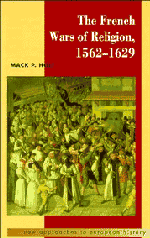Book contents
- Frontmatter
- Contents
- List of maps and figures
- Chronological table of events
- Introduction
- 1 Prologue: Gallicanism and reform in the sixteenth century
- 2 ‘The beginning of a tragedy’: the early wars of religion, 1562–1570
- 3 Popular disorder and religious tensions: the making of a massacre, 1570–1574
- 4 The rhetoric of resistance: the unmaking of the body politic, 1574–1584
- 5 ‘Godly warriors’: the crisis of the League, 1584–1593
- 6 Henry IV and the Edict of Nantes: the remaking of Gallicanism, 1593–1610
- 7 Epilogue: the last war of religion, 1610–1629
- 8 Conclusions: economic impact, social change, and absolutism
- Genealogical charts
- Brief biographies
- Suggestions for further reading
- Index
8 - Conclusions: economic impact, social change, and absolutism
Published online by Cambridge University Press: 05 June 2012
- Frontmatter
- Contents
- List of maps and figures
- Chronological table of events
- Introduction
- 1 Prologue: Gallicanism and reform in the sixteenth century
- 2 ‘The beginning of a tragedy’: the early wars of religion, 1562–1570
- 3 Popular disorder and religious tensions: the making of a massacre, 1570–1574
- 4 The rhetoric of resistance: the unmaking of the body politic, 1574–1584
- 5 ‘Godly warriors’: the crisis of the League, 1584–1593
- 6 Henry IV and the Edict of Nantes: the remaking of Gallicanism, 1593–1610
- 7 Epilogue: the last war of religion, 1610–1629
- 8 Conclusions: economic impact, social change, and absolutism
- Genealogical charts
- Brief biographies
- Suggestions for further reading
- Index
Summary
In the final analysis what are we to make of the French Wars of Religion? I have attempted in the preceding pages to demonstrate that religion – understood by contemporaries as something more social than intellectual – played a central role in these civil wars. Above all, the wars were experienced against the backdrop of the Reformation, where confessional division was common in many parts of sixteenth-century Europe. So, in this sense I have attempted to put religion back into the story that nineteenth- and early twentieth-century historians left out. Throughout the Wars of Religion I have tried to show that time and again the principal – though clearly not the sole – motivating force behind the violence of the civil wars was the perception of safeguarding and defending a sacred notion of community defined by religion, whether that be the Gallican and traditionally Catholic community of most French men and women, or the minority community of the saints of the Protestant faith. Each community sought to define – or for the Huguenots to redefine – the boundaries between the sacred and the profane for the whole. As a result, at various times each group viewed the other with great suspicion and as a clear threat to its own survival. The Catholic reaction to the series of peace edicts, the St Bartholomew's massacres, the mentality of the Catholic League, and even the Edict of Nantes itself all seem to me to accentuate the importance of religion: defined as a community of believers rather than a body of beliefs.
- Type
- Chapter
- Information
- The French Wars of Religion, 1562–1629 , pp. 190 - 216Publisher: Cambridge University PressPrint publication year: 1995

